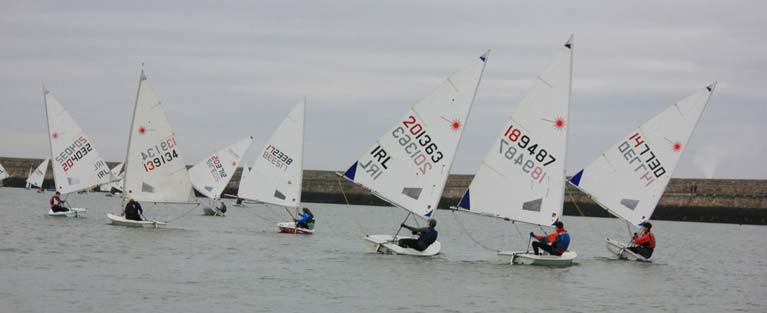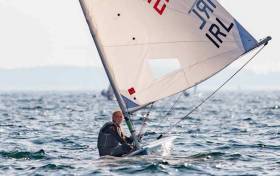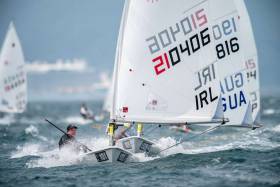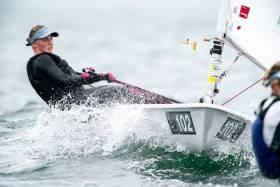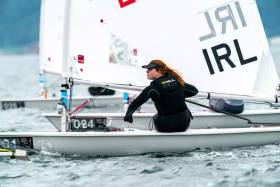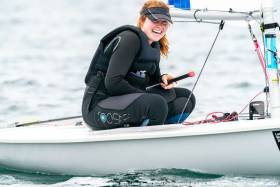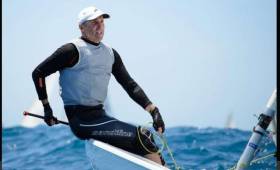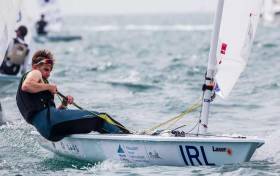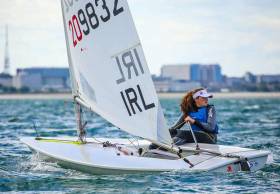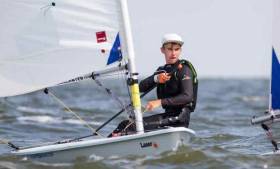Displaying items by tag: Radial
Laser Radial Fleet Ticks all the Right Boxes in DMYC Frostbite, Racing Resumes January 5th
Laser Radials competing in the DMYC Frostbites are now the largest club Laser fleet in Ireland and look likely to surpass last winter’s 37 boat entry, with weekly turnouts in the mid-20s.
Not bad, given there were just one or two Radials a couple of years ago and it’s a great accolade for the versatility of the mid-sized Laser rig. Series Two kicks off this Sunday, January 5th and sailors can enter here at effectively half price. New arrivals for the second series include Marco Sorgassi (who took a short break after an excellent 5th overall in the 50-boat Italian Masters in October) and John O’Driscoll, SOD and SB20 supremo, who will return after a nasty skiing injury twelve months ago.
With our sibling 4.7 and Standard rigs also out in healthy numbers, total Dun Laoghaire Laser numbers on the water each Winter Sunday are in the 40-50 range.
"Total Dun Laoghaire Laser numbers on the water each Winter Sunday are in the 40-50 range"
Somewhat accidentally, the Radials are also very on-point in terms of the buzzy catchphrases and promotions you hear bandied about. “Women on the Water” ? Box ticked, with ten female entries so far! “Sport for Life” and “Sport for All”? Well, yes indeed, with sailors aged 15-60 + and weights from 50 to (at least) 85 kgs.
Finally, we can rightfully claim some of that much sought-after “Youth Retention”, with graduates from 4.7s, some more experienced Radial Youths practising for the Europeans in Ballyholme in July and also some twenty-somethings getting back in after a few years out.
So….Retirees, Boomers, Generations X to Z, Millennials and even Frostbiting Snowflakes (sorry, couldn’t resist)….we’ve got them all ! The fleet breaks down into 80% adults and 20% youths.
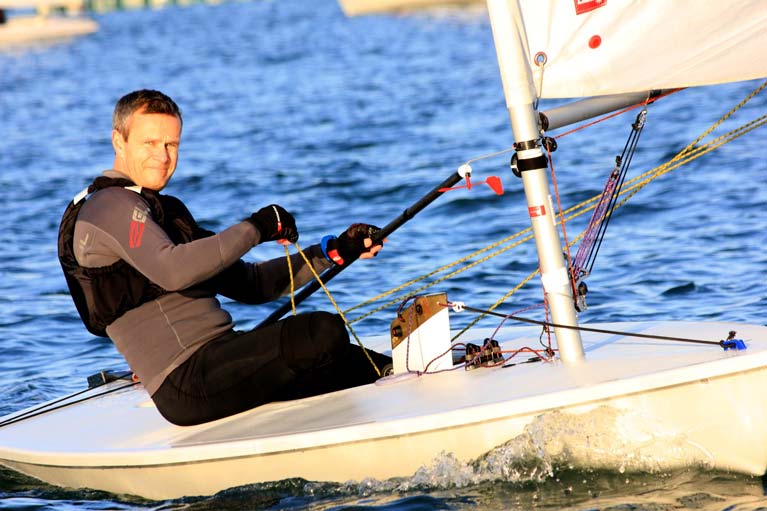 Gavin Murphy of the RStGYC Photo: Bob Hobby
Gavin Murphy of the RStGYC Photo: Bob Hobby
Anyway, regardless of how we all arrive on the starting line together, it’s certainly been super racing before Christmas, great fun and as competitive back in the twenties as it is in the top ten. Alas for the older guard, the young ‘uns have won the day so far. These guys are in fact anything but “Flaky Snowflakes”! They train hard on Sunday mornings before joining in for the Frostbites, seemingly oblivious to low temperatures. Under the stewardship of rotating DMYC Race Officers, Cormac Bradley and Ben Mulligan, race-management has been top-notch. At the sharp end of the fleet, Conor Gorman and Alana Coakley have taken most race wins. Ex-Topper star Hugh O’Connor has a bullet too, but a “Master” (over 35) has won one race only. Other young guns showing really well are Adam Walsh and Adam Leddy.
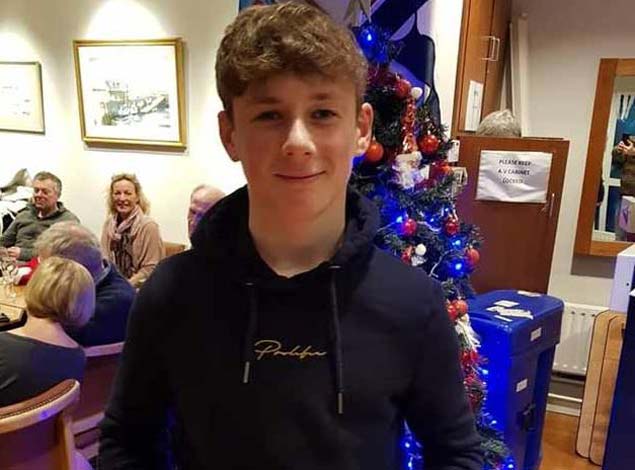 Conor Gorman of the National Yacht Club Photo: Frank Miller
Conor Gorman of the National Yacht Club Photo: Frank Miller
Overall, it was Conor Gorman (NYC) who took Series 1 with a very commanding points lead, discarding a 2nd place! Judy O’Beirne (RStGYC) was the first lady in 6th overall. Other Master sailors have had their moments and here there’s plenty of newcomers in the more mature category. DBSC Laser Class captain Gav Murphy has been trying out the Radial and plenty of other new Masters have appeared, but are well known in other classes, including Owen Laverty, Pierre Long and Hugh Cahill. Some may be long-term Radial converts, while others will just be staying fit and sharp for Summer campaigns in other fleets.
With mainly light winds so far, the bigger grislier sailors will surely feature when the Sundays turn squally and nasty. Or at least that’s what they’ve been saying in the bar after sailing!
Series 1 Results here
Howth Yacht Club Teenager Eve McMahon For Tokyo Olympic Trials
The Irish Tokyo Olympic trials for the women's Laser Radial nomination have been given added spice with the entry of fifteen-year-old Eve McMahon into next March's three trial series.
The Howth Yacht Club teenager is the Irish youth champion in the class and this summer became the under-17 Radial world champion.
It brings to four the number of helmswomen now planning to contest the series, including the return of the Rio Olympic silver medalist, Annalise Murphy.
Sailing Correspondent David O'Brien has much more in this morning's Irish Times here.
Following the final two races at the Laser Radial World Championship this morning, Ireland has qualified for the Tokyo 2020 Olympic Sailing regatta in the women’s single-handed event, the only sailing discipline so far in which Ireland has qualified.
The berth was secured by the current Irish Radial Champion, Lough Derg Yacht Club’s Aisling Keller (Nenagh, Co. Tipperary) who had her best day in the Gold fleet final series to finish 46th overall in the 56-boat Gold fleet.
“This is a weight off my shoulders for sure, it’s probably the hardest regatta I’ve ever sailed,” Keller said. “To come in off the water and know that it’s done and dusted is just amazing (I’m) so happy.”
Howth Yacht Club’s Aoife Hopkins placed 48th and both Irish sailors were inside the qualification criteria with Keller taking the seventh of ten-nation places decided at the championship. Hopkins would otherwise have been in the ninth nation place.
“It’s been a really long road to this moment. We’ve been working for a year towards this event particularly and even longer towards Olympic qualification,” said Hopkins. “It’s really nice to come away with the outcome we wanted.”
The world championship was won by Denmark’s Anne-Marie Rindom who led overall going into to the final day of Gold fleet racing on Wednesday. Ten nation places for Tokyo 2020 were also decided at the event in addition to the 20 already won in 2018.
Now that Ireland has qualified, an Irish Olympic Trials Series will be held to determine which sailor represents Ireland in Tokyo. More details on the Olympic Trials format is here.
“Qualification was something that had to happen so that ended up being the focus here at the end of the regatta,” said Rory Fitzpatrick, Irish Sailing’s Head Coach. “Next we go to the Olympic venue (at) Enoshima… now that we know we’re going to be there (at the Games) we’ve got to make the most of it.”
The sailing venue for next year’s Olympic regatta will host national representatives in all events next month for a scheduled test series for competitors and organisers alike.
Results here
With just two races remaining at the Laser Radial World Championships in Sakaiminato, Japan to be sailed on Wednesday, both Irish Olympic campaigners are within reach of the single Irish qualification place for Tokyo 2020. Ten nation places are being decided this week.
Aoife Hopkins (Howth, Co. Dublin) moved up a place after the penultimate day’s racing to 41st place while team-mate Aisling Keller (Nenagh, Co. Tiperary) slipped down the standings from 40th to 49th.
However, Hopkins’ overall position equates to fifth nation while Keller’s result would be tenth nation: mathematically, it is still possible that both sailors could slip outside the criteria on the final day.
The Howth sailor was disqualified for premature starting in the opening race of the day though sailed the course amongst the leading boats. She then scored a 25th in the race that followed while using the single discard to drop the earlier disqualification.
Meanwhile, her team-mate from Lough Derg sailed well in the opening stages of both races but suffered on the downwind legs as conditions were the freshest of the series so far.
“Aoife did exactly what she needed to do after the disqualification - get stuck in and get a good result,” said Rory Fitzpatrick, Irish Sailing’s Head Coach. “Her confidence and momentum are growing with the experience of racing at this level.”
Two final races are scheduled for Wednesday (early-morning Irish time) that will decide the world championship that is currently led by Denmark’s Anne-Marie Rindom.
Subject to qualification for Tokyo 2020 at this opportunity, a selection trial series will follow next year. A further qualification opportunity also exists for European nations in Genoa in April.
Genoa will also be the qualification opportunity for the men’s single-handed Laser event while Ireland’s skiff sailors will seek qualification for the Olympics at the 49er and 49erFX men and womens’ world championships in New Zealand in November.
Results are here
With just four races remaining at the Laser Radial World Championship in Japan, Ireland’s Aisling Keller and Aoife Hopkins are on target to secure Ireland's berth on the Tokyo startline in the Laser Radial class.
Both Keller (Nenagh, Co. Tipperary) and Hopkins (Howth, Co. Dublin) are placed 40th and 42nd in the 56-boat Gold fleet final round of the championship that started last Friday.
Hopkins had the stronger day on Monday with two top 30 results while Keller had two 42nd places, one of which she drops using the discard system. Another discard comes into force if the series achieves ten races.
Keller had been in 15th place in the second race but received a 'yellow flag' penalty for excessive propulsion technique and dropped back after taking the mandatory turn.
Conditions on Miho Bay, Sakaiminato have proven tricky for competitors and organisers alike with light, shifty winds delaying racing and causing the qualification series to miss one race.
Results here.
Lough Derg Yacht Club's Aisling Keller Continues to Lead Irish Laser Radial Hopes in Japan
Lough Derg Yacht Club's Aisling Keller continues to lead Irish hopes of Olympic qualification at the Laser Radial World Championships today.
Both Irish women competing at the World Championships in Sakaiminato, Japan achieved top 20 results as the pair aim to secure the single place for Ireland at the Tokyo 2020 Olympic Games.
Aisling Keller (Nenagh, Co. Tipperary) had a 14th place while Aoife Hopkins (Howth, Co. Dublin) was 17th in the single race day for their 55-boat Blue flight.
The moderate breeze that the two qualification flights started in proved quite unstable and soon eased to near calm conditions. Plans for a second race were dropped.
As Afloat reported previously, a second day of slack winds on Miho Bay has put the qualification round behind schedule and while three races may be attempted on Sunday, the finals series must begin on Monday regardless.
Two races on Sunday would see the series discard come into force and allow Hopkins to drop her 34th place from the opening day to maximise her potential to achieve Gold fleet for the finals.
“We have good momentum now so I’m pretty happy that Aisling and Aoife have settled in,” said Rory Fitzpatrick, Irish Sailing’s Head Coach.
Ten nation places for the women’s single-handed dinghy in Tokyo will be decided at this world championship in addition to the 20 already allocated from 2018 events. Either or both Irish sailors must first qualify for Gold fleet on Sunday and score well by Wednesday’s final race to achieve Irish qualification.
Royal St. George's Sean Craig has finished third at the BDO Barcelona Masters Laser Radial Regatta today, a warm-up event for the European Masters in Roses, Spain next weekend.
The 60-boat event began with a windy and wavy first day, a tricky second day with very confused seas in 8-10 knots and finished with no wind today and no racing.
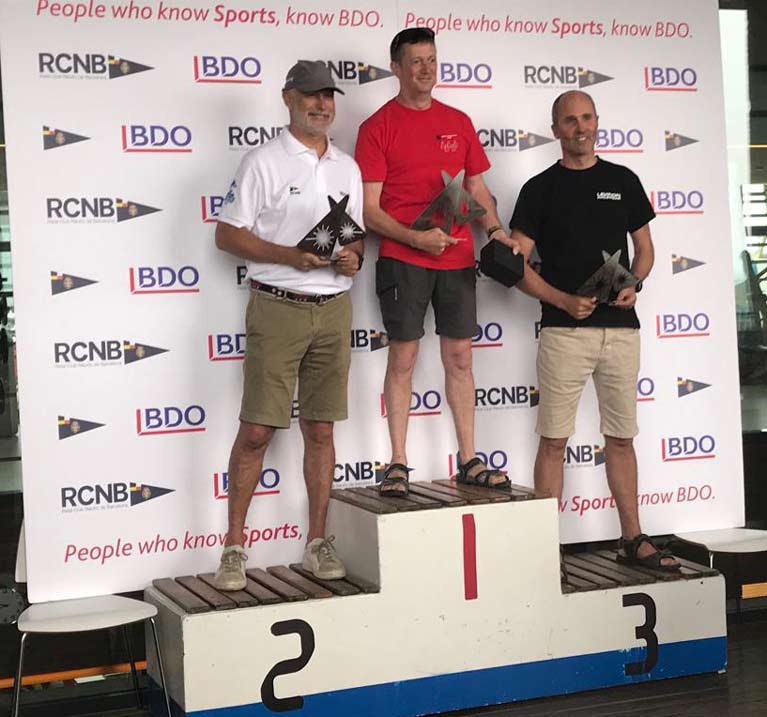 Dublin's Sean Craig on the Laser podium in Barcelona
Dublin's Sean Craig on the Laser podium in Barcelona
The winner was Ian Jones, who was second in the Masters Division at the Dun Laoghaire World Championships last September.
The Spaniard in second is also in the Grand Master Division like Craig. Next weekend's Roses event has 120 Radials entered and is expected to be a much more competitive affair.
Tough Start for Irish Youth Sailors on Chinese Waters
Today was the first day of competition for 374 of the world's best youth sailors, from 60 nations, racing across nine classes on Chinese waters at the World Youth Sailing Championshps in which Ireland is contesting three classes and hoping to replicate or better its 2014 silver and 2016 bronze medals. More team details here.
Grey skies and a variable 6–12 knot easterly breeze were present across the four racing areas and sailors were looking to get off to a steady start. See video below.
Best of the Irish after two races – with a long way to go in this competition – is Rush Sailing Club's Conor Quinn in the boys Laser radial class who scored an 11th in the second race of the day to be in the top 40% of his fleet, now lying 21st overall out of 51 starters.
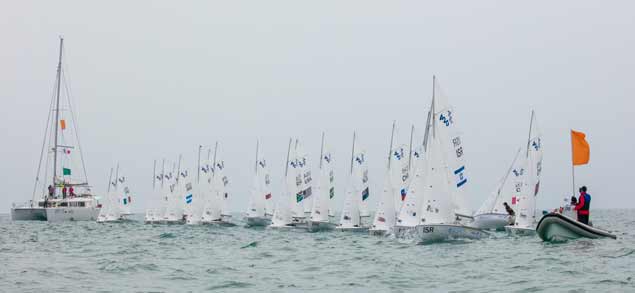 A boys 420 start in Sanya
A boys 420 start in Sanya
In the boys 420 class, Geoff Power and James McCann are 22 from 26 and will be hoping for better in the following races this week. In June, the Dunmore East pair scored an impressive seventh overall at Kiel Week in Germany.
Belfast Lough's Sally Bell, the RYA NI youth sailor of the year, is lying 26th from 40.
Click this link for the official results sheet here.
? | Check out the highlights from Day 1️⃣ of racing at the 2017 Youth Worlds in #Sanya ??
— Youth Sailing Worlds (@youthworlds) December 11, 2017
For full results head to ➡️ https://t.co/3uG36YRjJQ#youthworlds #yswcsanya pic.twitter.com/Bl08mHH6pC
USA's Charlotte Rose put out a strong signal of intent by dominating the day in the Girl's Laser Radial.
Racing in the 40-boat fleet, Rose won both races, sending out a message to the defending champion Dolores Moreira Fraschini (URU) and 2017 Youth Radial World Champion, Hannah Anderssohn (GER).
Rose did more than this, she controlled the fleet sealing two convincing victories. The American finished third to Moreira Fraschini and Anderssohn at the 2017 Youth Radial World Championships in Medemblik, the Netherlands in August and although she was anxious about the scale of the event, she remains calmly focused and competitive.
"The Youth Worlds is the top sailors in every country from around the world so that gets me a little nervous,” commented Rose. "These sailors qualified to be here and deserve to be here as much as I am. Just knowing that puts a little of pressure on.
"But I'm also not scared of them. They're still a threat to me but I deserve to win as much as they do. As long as I work harder and smarter than them, I can beat them.”
Moreira Fraschini, a Rio 2016 Olympian and defending champion, kept in sight of Rose and posted a 3-2 to sit within three points. Annabelle Rennie-Younger (NZL) and Luciana Cardozo (ARG) are tied on 15 points in third.
Germany's Anderssohn received a scoring penalty in the opening race and followed with a 12th. She is currently 30th overall but the discard comes into after the third race so she will have opportunities to spring up the leaderboard.
Italy's Guido Gallinaro holds the early lead in the 51-boat Boy's Laser Radial fleet after a second and a seventh from two races.
New Zealand's Josh Armit won the opening race and after racing said, "It's a tough competition and great to be sailing against all these great guys. The second race I didn't have that great of a start and struggled from there to work back through the pack.”
Armit finished 12th in the second race and occupies fifth overall. Yoshihiro Suzuki (JPN) also took a race win and is in fourth.
Norway's Mathias Berthet and Alexander Franks-Penty stole the show in the 30-boat Boy's 29er fleet.
They won two races and finished third in the other and were full of smiles ashore after racing, "We were very nervous at the start because we didn't have a good feeling in the practice day. I think we managed this pretty well today,” explained a modest Franks-Penty.
"We hit the good shifts and that was pretty important. Our starts were very clean and good.
"All in all, it's been a perfect day for us, it couldn't have gone any better.”
Sweden's Kasper Nordenram and Linus Berglund and France's Théo Revil and Gautier Guevel follow in second and third.
Margherita Porro and Sofia Leoni (ITA) were more impressive in the 20-boat Girl's 29er fleet, winning every single race. Zoya Novikova and Diana Sabirova (RUS) followed behind in the first two races but dropped to 12th in the final race of the day. They discard the 12th and are two points off the Italians.
Maiwenn Jacquin and Enora Percheron (FRA) complete the podium but it is still the early stage of the regatta.
There was plenty for the Chinese fans to cheer about in the Boy's and Girl's RS:X with Chinese sailors firmly placed within the leading bunch after three races.
Ting Yu (CHN) leads defending champion Emma Wilson (GBR) by one point in the Girl's RS:X fleet following two race wins and a third. Giorgia Speciale (ITA) and Yarden Isaak (ISR) are in contention in third and fourth.
Hao Chen (CHN) is one point off leading Israeli sailor Yoav Cohen following three races in the Boy's RS:X. Alongside a third, Cohen picked up two race wins. Chen took the final race win of the day.
Fernando Gonzalez de la Madrid Trueba (ESP) occupies the final podium position.
In the Boy's 420, Ido Bil and Noam Homri (ISR) lead the pack after a race win and a second. Australia's Otto Henry and Rome Featherstone follow in second and USA's Thomas Rice and Trevor Bornarth are third. In the Girl's division, Israel's Linoy Korn and Yael Steigman lead Carmen Cowles and Emma Cowles by two points.
Belgium's Lucas Claeyssens and Anne Vandenberghe (BEL) were in firm control in the Nacra 15 winning two races and picking up a second in the other. The Youth Worlds is open to competitors under 19 which makes the young teams form even more impressive as Claeyssens is just 13-years-old.
Belgium holds the record for the youngest competitor at the Youth Worlds. At just 11-years-old, Henri Demesmaeker sailed at the 2012 edition in the multihull. He went on to make three further appearances and won bronze in 2016.
If Claeyssens and Vandenberghe continue their form, the young helm could become the youngest medallist at the event.
Racing is scheduled to resume at 11:00 local time on Tuesday 12 December.
Top Irish Youth Sailors Head for World Champs in China
Irish youth sailors will join a fleet from 62 nations set to compete in the 2017 edition of the Youth Sailing World Championships from 9-16 December 2017 in Sanya, China.
As Afloat.ie reported prevously, Ireland will be represented by three boats and four sailors: Sally Bell in Laser Radial Girls, Conor Quinn in Laser Radial Boys, and Geoff Power and James McCann in 420s.
The team will be joined by coach Russell McGovern.
On the eve of her departure for China, Bell was boosted with the 2016 RYA NI Youth Sailor of the Year Award.
More than 380 competitors will race across nine youth events over five days of racing in a bid to follow in the footsteps of some of the greatest names in sailing who have competed at the event.
Some of the famous faces include Ben Ainslie (GBR), five-time Olympic medallist, Russell Coutts (NZL), America's Cup winner, Santiago Lange (ARG), Rio 2016 legend and Alessandra Sensini (ITA), one of the most successful Olympic sailors of all time.
The names collected on the nine perpetual trophies, since the events inception in 1971, reads like a who's who in sailing.
The world's best youth sailors will all be heading to Sanya aiming to write their names in the history book to emulate the stars of the sport.
Laser Radial
The Girl's Laser Radial fleet will welcome 40 talented competitors. Sailors with experience at the Youth Olympic games and World Championships will all be at the start line. The one name that shines in the fleet is Uruguay's Dolores Moreira Fraschini.
At just 18-years-old, Fraschini has achieved a lot in her short career so far. In 2016, she qualified Uruguay for a spot at the Rio 2016 Olympic Games in the Laser Radial and was selected to compete for her nation. Not only was she selected but she was chosen to carry the Uruguayan flag in the opening ceremony.
Just a few months later at the 2016 Youth Worlds in Auckland, New Zealand, she claimed gold for herself and nation in the Laser Radial fleet, capping off a tremendous year of competitive sailing.
Fraschini is the only returnee of the medallists from 2016 and will be looking to defend her crown against a very strong line up of sailors.
In the entrants is Hannah Anderssohn of Germany. Anderssohn beat Fraschini to gold earlier this year at the Laser Radial Youth World Championships in Medemblik, the Netherlands and knows what it takes to win.
Charlotte Rose (USA) finished third behind Anderssohn and Fraschini at the Radial Youth Worlds. She will also be in Sanya, aiming for the podium once again.
It's not just Youth Worlds experience within the Laser Radial fleet. Australia's Elyse Ainsworth sailed at the 2014 Youth Olympic Games in Nanjing, China. Racing in the Byte CII, Ainsworth finished 24th but since she stepped into the Laser Radial, she has finished amongst the frontrunners at Sailing's World Cup Series Final in Melbourne in 2016 and is improving in the senior ranks.
In the Boy's Laser Radial, there will be 51 skilled sailors competing in Sanya.
Amongst that fleet, the winner of the 2017 Youth Laser Radial World Championship, Dimitris Papadimitriou (GRE), will be attending and seeking to claim the top spot.
Papadimitriou dominated the Laser Radial Worlds, winning by a considerable margin over Matias Dietrich from Argentina.
Dietrich will be in Sanya and has been training to improve on his Radial Youth Worlds performance to take gold home for Argentina.
Josh Armit (NZL) missed out on Bronze at Radial Youth Worlds via a countback. Armit will be attending the Youth Worlds hoping to make amends.
Only two returnees from the top ten of the 2016 Youth Worlds will return for 2017.
Dominik Perkovic (CRO) and Clemente Sequel (CHI) finished ninth and tenth respectively and will be aiming to improve on their performance on Chinese waters.
Racing will also take place in the Boy's and Girl's 420, Boy's and Girl's 29er and the Open Mulithull, the Nacra 15 and the RSX.
Sailors will be officially welcomed to Sanya on Sunday 10 December with the opening ceremony. Racing is scheduled to commence at 11:00 local time on Monday 11 December and will conclude on Friday 15 December.
Irish Laser sailor Conor Quinn, from Rostrevor and a member of Carlingford Lough Yacht Club (CLYC) and Rush Sailing Club (RSC) is on his way to China this December as the as the sole Irish Laser Radial representative at the Under–19 Youth Sailing World Championships in China in December.
Part of the RYANI Performance Academy, Quinn also trains with the Irish Sailing (ISA) Youth Academy.
Further to Quinn’s impressive sailing efforts this summer, he also secured a place at Newcastle University to study Accounting & Finance, a course in which he embarks on in the coming weeks.
Receiving the prestigious nomination for China tops a successful summer for the young sailor, having also represented Ireland at the European Championships in Gdynia, Poland and the World Championships in Medemblik, Holland, at which he finished 31st and 32nd place respectively in a highly competitive field from over 50 countries.
“I hope to continue my good run of form into China and am hungry for further success on the international stage, Quinn told Afloat.ie


























